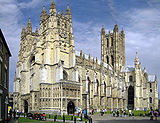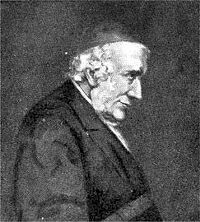- Oxford Movement
-
Not to be confused with the twentieth-century Oxford Group.
The Oxford Movement was a movement of High Church Anglicans, eventually developing into Anglo-Catholicism. The movement, whose members were often associated with the University of Oxford, argued for the reinstatement of lost Christian traditions of faith and their inclusion into Anglican liturgy and theology. They conceived of the Anglican Church as one of three branches of the Catholic Church.
It was also known as the Tractarian Movement after its series of publications Tracts for the Times, published between 1833 and 1841. The group was also disparagingly called Newmanites (pre-1845) and Puseyites (post-1845) after two prominent Tractarians, John Henry Newman and Edward Bouverie Pusey. Other well-known Tractarians included John Keble, Charles Marriott, Richard Hurrell Froude, Robert Wilberforce, Isaac Williams and William Palmer.
Contents
Early movement
The immediate impetus for the movement was a perceived secularization of the church, focused particularly on the decision by the government to reduce by ten the number of Irish bishops in the Church of Ireland following the 1832 Reform Act. Keble attacked these proposals as 'national apostasy' in his Assize Sermon in Oxford in 1833. The movement's leaders attacked liberalism in theology. Their interest in Christian origins led them to reconsider the relationship of the Church of England with the Roman Catholic Church.
The movement postulated the Branch Theory, which states that Anglicanism along with Orthodoxy and Roman Catholicism form three "branches" of the one "Catholic Church". Men in the movement argued for the inclusion of traditional aspects of liturgy from medieval religious practice, as they believed the church had become too "plain". In the final Tract XC, Newman argued that the doctrines of the Roman Catholic Church, as defined by the Council of Trent, were compatible with the Thirty-Nine Articles of the sixteenth-century Church of England. Newman's conversion to Roman Catholicism in 1845, followed by that of Henry Edward Manning in 1851, had a profound effect upon the movement.
Publications
Apart from the Tracts for the Times, the group began a collection of translations of the Fathers, which they called the Library of the Fathers and which in the end ran to 48 volumes, the last published three years after Pusey's death. These were issued through Rivington's, under the imprint of the Holyrood Press. The main editor for many of these was Charles Marriott. A number of volumes of original Greek and Latin texts were also published.
Criticisms
The Oxford Movement was attacked for being a mere "Romanising" tendency, but it began to have an influence on the theory and practice of Anglicanism. It resulted in the establishment of Anglican religious orders, both of men and women. It incorporated ideas and practices related to the practice of liturgy and ceremony in a move to bring more powerful emotional symbolism and energy to the church. In particular it brought the insights of the Liturgical Movement into the life of the Church. Its effects were so widespread that the Eucharist gradually became more central to worship, vestments became common, and numerous Catholic practices were re-introduced into worship. This led to controversies within churches that ended up in court, as in the dispute about ritualism.
Partly because bishops refused to give livings to Tractarian priests, many of them ended up working in the slums. From their new ministries they developed a critique of British social policy, both local and national. One of the upshots was the establishment of the Christian Social Union, of which a number of bishops were members, where issues such as the just wage, the system of property renting, infant mortality and industrial conditions were debated. The more radical Catholic Crusade was a much smaller organisation than the Oxford Movement. Anglo-Catholicism, as this complex of ideas, styles and organizations became known, had a massive influence on global Anglicanism.
Paradoxically, the Oxford Movement was attacked both for being secretive and broadly collusive. This position is well documented in Walsh's The Secret History of the Oxford Movement.[1]
Receptions into the Roman Catholic Church
One of the principal writers and proponents of the Tractarian Movement was John Henry Newman, a popular Oxford priest who, after writing his final tract, Tract 90, became convinced that the Branch Theory was inadequate and was received into the Roman Catholic Church in 1845. He was ordained a priest in that church in the same year and later became a cardinal. He was one of a number of Anglican clergy who became Roman Catholics during the 1840s who were either members of, or were influenced by, the Tractarian Movement. Some opponents of the Oxford Movement viewed this as proof that the movement had sought to "Romanise" the church.[citation needed]
Other major figures influenced by the movement who became Roman Catholics included:
- Thomas William Allies, Church historian and former Anglican priest
- Edward Lowth Badeley, ecclesiastical lawyer
- Robert Hugh Benson, son of the Archbishop of Canterbury, novelist and monsignor
- John Chapman OSB, patristic scholar and Roman Catholic priest
- Augusta Theodosia Drane, writer and Dominican prioress
- Frederick William Faber, theologian, hymn writer, Oratorian and Roman Catholic priest
- Gerard Manley Hopkins, poet and Jesuit priest
- Robert Stephen Hawker, poet and Anglican priest, received on his deathbed
- James Hope-Scott, barrister and Tractarian, received with Manning
- Ronald Knox, Biblical texts translator and formerly an Anglican priest
- Henry Edward Manning, later Cardinal Archbishop of Westminster
- George Jackson Mivart, biologist, later excommunicated by Cardinal Herbert Vaughan
- John Brande Morris, Orientalist, eccentric and Roman Catholic priest
- Augustus Pugin, architect
- William George Ward, theologian
- Benjamin Williams Whitcher, American Episcopal priest
Others associated with Tractarianism
- Christina Rossetti
- Alexander Penrose Forbes
- George Cornelius Gorham
- George Anthony Denison
- James Bowling Mozley
- Renn Dickson Hampden
- Richard William Church
- Thomas Mozley
- Walter Farquhar Hook
- John Mason Neale
- William Ewart Gladstone
See also
- Anglican Breviary
- Anglican Communion
- Confraternity of the Blessed Sacrament
- Guild of All Souls
- Neo-Lutheranism
- Society of the Holy Cross
- Society of King Charles the Martyr
- Society of Mary (Anglican)
- Personal Ordinariate of Our Lady of Walsingham
References
- Henry Parry Liddon, Life of E. B. Pusey, 4 vols. London (1893). The standard history of the Oxford Movement, which quotes extensively from their correspondence, and the source for much written subsequently. The Library of the Fathers is discussed in vol. 1 pp. 420–440. Available on archive.org.
- John Burgon, Lives of Twelve Good Men. Includes biography of Charles Marriott.
- Faught, C. Brad (2003). The Oxford Movement: A Thematic History of the Tractarians and Their Times, University Park, PA: Pennsylvania State University Press, ISBN 978-02-71022-499
- Richard W. Pfaff, "The library of the fathers: the tractarians as patristic translators", Studies in Philology 70 (1973), p. 333ff.
- Leech, Kenneth and Williams, Rowan (eds) (1983) Essays Catholic and Radical: a jubilee group symposium for the 150th anniversary of the beginning of the Oxford Movement 1833-1983, London : Bowerdean, ISBN 0-906097-10-X
- Norman, Edward R. Church and Society in England 1770–1970: a historical study (Oxford, Clarendon Press, (1976), ISBN 0-19-826435-6.
- Nockles, P. B. The Oxford Movement in Context: Anglican High Churchmanship 1760-1857 (Cambridge, CUP, 1996).
- Skinner, S. A. Tractarians and the Condition of England: The social and political thought of the Oxford Movement (Oxford, Clarendon, 2004) (Oxford Historical Monographs.)
- Pereiro, J. ‘Ethos’ and the Oxford Movement: At the Heart of Tractarianism (Oxford, OUP, 2007).
- Crumb, Lawrence N. The Oxford Movement and Its Leaders: A Bibliography of Secondary and Lesser Primary Sources (Lanham, MD: Scarecrow Press, 2009 (ATLA Bibliography Series, 56).
Notes
External links
- Traditional Anglican Catholics in the Diocese of Lincoln
- Tracts for the Times
- The Oxford Movement: Twelve Years 1833-1845 by R. W. Church
- The Secret History of the Oxford Movement by Walter Walsh
- Religious Thought in the Oxford Movement By Clement Charles Julian Webb
- Tractarianism (Schaff-Herzog Encyclopedia of Religious Knowledge)
- Anglo-Catholic Socialism
Categories:- History of Oxford
- Anglo-Catholicism
- Christianity in Oxford
- History of the Church of England
- 19th-century Christianity
Wikimedia Foundation. 2010.


